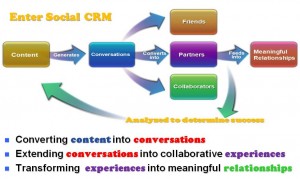Social CRM is a buzz word that is spiralling out of control at the moment. What does it mean? I googled around and didn’t really find a consistent message. Instead I am going to explain my interpretation, let me know if you think it makes sense.
Social networks have two strong points, they are full of customers that are linked by relationships. These are the first two letters of CRM! The multi-billion dollar question is how can you manage them without destroying them or being seen as an evil spy.
The first step towards Social CRM is using social networks as a feedback loop for your customer relations programs. Who better to learn from than your customers themselves? It’s the perfect way to refine your customer relations processes and add another source of feedback and innovation into your company.
The next stage is to develop relationships with your customers. From a business perspective I would assume that this is due to repeat business delivering higher margins, mostly because it doesn’t require expensive mass marketing or other customer acquisition. Businesses justify it to consumers by saying it gives the customer an opportunity to dictate and receive a personalised product.
I like idealistic goals, I think when you are talking about customers it is good to at least aim towards being noble. The question is, how many businesses intentions are simply to maintain the margins of their mass market product?
As with everything in life there will be a balancing point, somewhere in the feedback gathering process I think the social networks will reject further interference. That balancing point is what Facebook and others are thinking day and night about, and the point they have crossed at times with projects such as Facebook Beacon. If a social network hits that point perfectly there is definitely big money at stake, but until then companies need to monitor the social networks in their backyard and just listen. There are plenty of companies that struggle to do that internally, let alone through fast moving external networks.



